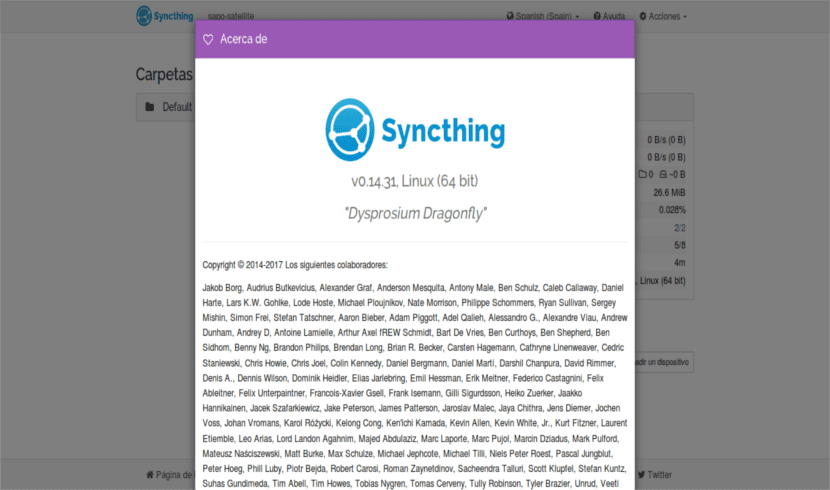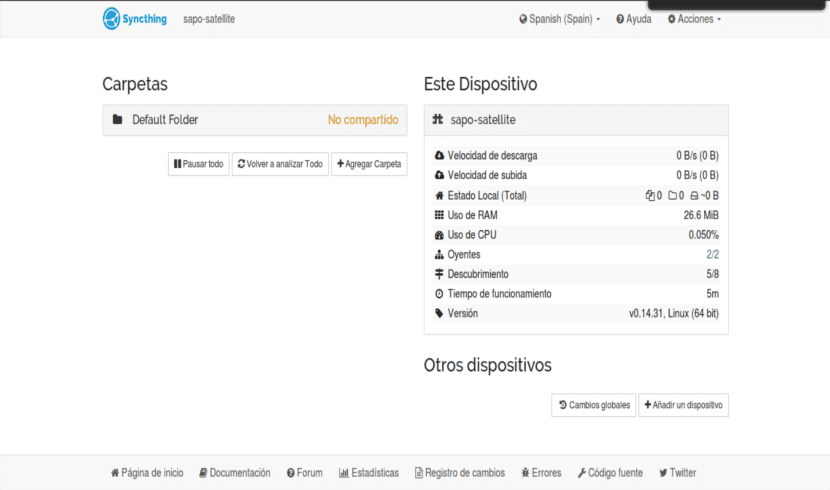
In the next article we are going to take a look at syncthing. This is a open source software continuous file synchronization. Will allow us sync files between two or more computers on a network.
Today data is perhaps the most important thing that users can save on their devices. Therefore, every user deserves to choose where to store their information. If it is shared with a third party or if it is transmitted over the Internet. Before proceeding to install Syncthing on Ubuntu, let's take a quick look at what it offers.
In this article we are going to see this application that will allow us easily sync files between two machines. To do this, Syncthing distinguishes between the "local device" is the one that will be configuring and the "remote device" that will be the other machine.
The best way to get a good synchronization is to install this program on both machines and configure them in parallel. If both machines are not accessible simultaneously it will not matter, but the results will be a little less obvious.
Synchronization functions with Syncthing
- Synchronization is done at a reasonable speed to avoid data corruption, as well as protected from external attacks, eavesdropping or modifications by an unauthorized party.
- The application is accessible, understandable and translated into several languages.
- All communication is assured, as well as encrypted using TLS.
- It is a cross-platform program as it runs on Linux, Windows, Mac OS X, Solaris, FreeBSD, Dragonfly, OpenBSD, as well as NetBSD.
In the latest version of Syncthing which is 0.14.32, different changes have been made with respect to previous versions. Among the most prominent, it should be noted that now the list of nearby devices adequately filters the devices that are already in the configuration. "Nearby devices" are now displayed in the add device dialog, thus avoiding the need to type your device ID. Folders that were once ignored in a share request now work correctly when added manually later. You can check all the features in more detail in the official documentation of the application.
How to install Syncthing on Ubuntu
We will have the option of using two channels for the installation. You can first try the installation from the stable option. It is necessary to open a terminal (Ctrl + Alt + T) and write the following commands:
curl -s https://syncthing.net/release-key.txt | sudo apt-key add - echo "deb https://apt.syncthing.net/ syncthing stable" | sudo tee /etc/apt/sources.list.d/syncthing.list sudo apt update && sudo apt install syncthing
If the stable channel is not up to date or for whatever reason it is not available, you can choose to install it from the candidate channel:
curl -s https://syncthing.net/release-key.txt | sudo apt-key add - echo "deb https://apt.syncthing.net/ syncthing candidate" | sudo tee /etc/apt/sources.list.d/syncthing.list sudo apt update && sudo apt install syncthing
Launch Syncthing
From the terminal we call this program using its name:
syncthing
The Administrator GUI starts automatically and remains available in https://localhost: 8384/. Cookies are essential for the proper functioning of the graphical interface. Make sure your browser accepts them.

On the left is the list of "folders", or directories to sync. You can see that the default folder for the user and that it is marked as "Not shared" as it has not been shared with any other device yet. On the right is the list of devices. The screenshot shows that there is only one device: the computer it is running on.
For this application to be able to sync files with another device, it must be reported about that device. This is accomplished by exchanging "device identifiers". A device identifier is a unique identifier, cryptographically secure. This is created as part of key generation the first time you start this program. It is printed in the record above, and can be viewed in the web GUI by selecting the "Actions" (top right) and "Show ID".
Two devices only connect and talk to each other if they are both configured with the other's device ID. Since the configuration must be mutual for a connection to occur, device identifiers do not need to be kept secret. They are essentially part of the public key.
For your two devices to communicate, just click "Add Device" at the bottom right of both, and type the ID of the device on the other side. You must also select the folders you want to share. You can see in more detail how to configure this application in your official documentation.
Uninstall Syncthing
To eliminate this program from our system we will only have to open a terminal (Ctrl + Alt + T). In it you will have to write the following order:
sudo apt remove syncthing